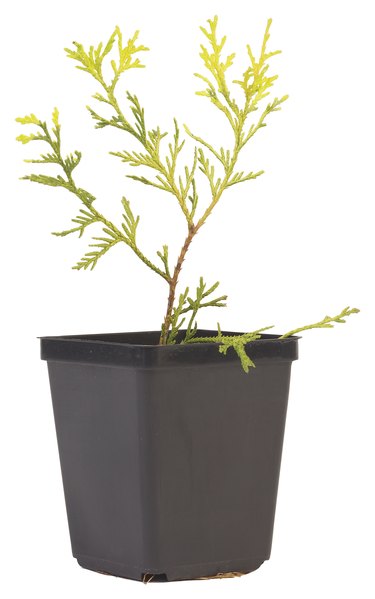
Deer browse upon several types of cedar commonly planted as ornamentals. Some cedar species provide more palatable forage than others and stand more chance of serious damage. In severe winters, deer could feed heavily on even eastern red cedar, one of the least popular types. Whether a cedar recovers depends upon the extent of damage and the age of the tree.
Cedar Growth Patterns
Video of the Day
When deer eat the buds and twigs of deciduous trees, the trees respond by replacing the lost parts with new shoots that sprout from older wood. Many seedling deciduous trees recover even if cropped to the ground. Evergreen growth patterns puts trees like eastern or western red cedar at greater risk for fatal damage. If browsing deer strip the tree of all green growth, the older wood will not produce new growth and the tree dies. If deer eat only the tender tips of branches, leaving greenery on the tree, the cedar replaces the lost portions of canopy.
Video of the Day
Dangers to Seedlings
The feeding technique deer use causes more harm to seedlings than to established trees. Deer have no front incisors, so when browsing on woody plants, a deer breaks and twists off the tips of branches instead of making a clean cut. A deer browsing on a newly transplanted seedling can uproot the entire plant. When the Virginia Department of Game and Inland Fisheries planted 70,000 Atlantic white cedar seedlings in Virginia's Great Dismal Swamp in 2008, white-tailed deer destroyed 24 percent of the unfenced trees. Deer pulled many of the seedlings completely out of the ground, says the North Carolina Cooperative Extension.
Deer-resistant Cedars
Not all cedars present the same quality of browse to deer populations. Planting deer-resistant cedars give the landscape planting a better opportunity to survive to maturity. Deer find western red cedars, a species native to the Pacific Northwest and Rocky Mountains, especially attractive and browse on its foliage year-round. Atlantic white cedar suffers most browsing damage in January. Juniper -- commonly known as eastern red cedar -- contains a bitter oil in its needles that deer dislike. Deer will browse eastern red cedar, but less often than other cedars. Eastern red cedar ranks among the least browsed plants in south Texas, according to Texas A&M's AgriLife Extension.
Age Benefits
Browsing deer kill only small cedars. Any cedar with the majority of its branches above the reach of deer could suffer major damage to lower limbs and still survive. If deer browse only half the length of the green tips of branches, a small cedar should recover. Damage to the tree's top leader could stimulate competing replacement shoots during the next season, but careful pruning restores the tree's original shape. Where deer cause problems with landscape plantings, cylinders of wire fencing set around small trees protect them from fatal nibbling. Hot pepper spray also helps, but the effect lasts only about 30 days, according to the North Carolina Cooperative Extension.
- Virginia Cooperative Extension; A Guide to Successful Pruning -- Pruning Evergreen Trees; Susan C. French, et al.; May 1, 2009
- North Carolina State University Cooperative Extension; Browsing Trends...; Jacqueline D. Roquemore, et al.
- USDA Natural Resources Conservation Service; Plant Guide -- Western Red Cedar; Guy Nesom
- West Virginia University Extension Service; Resistance of Ornamentals to Deer Damage; John W. Jett